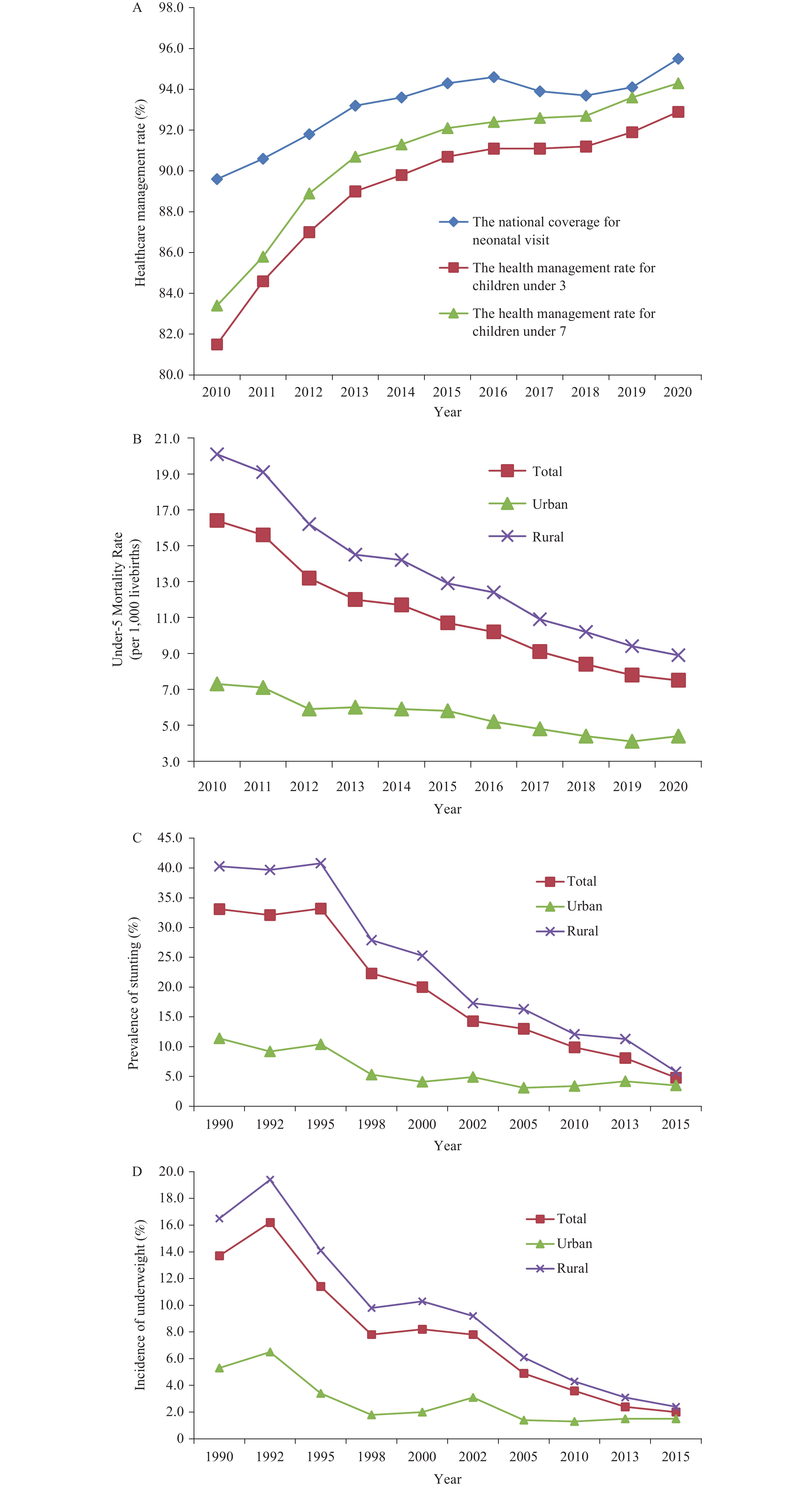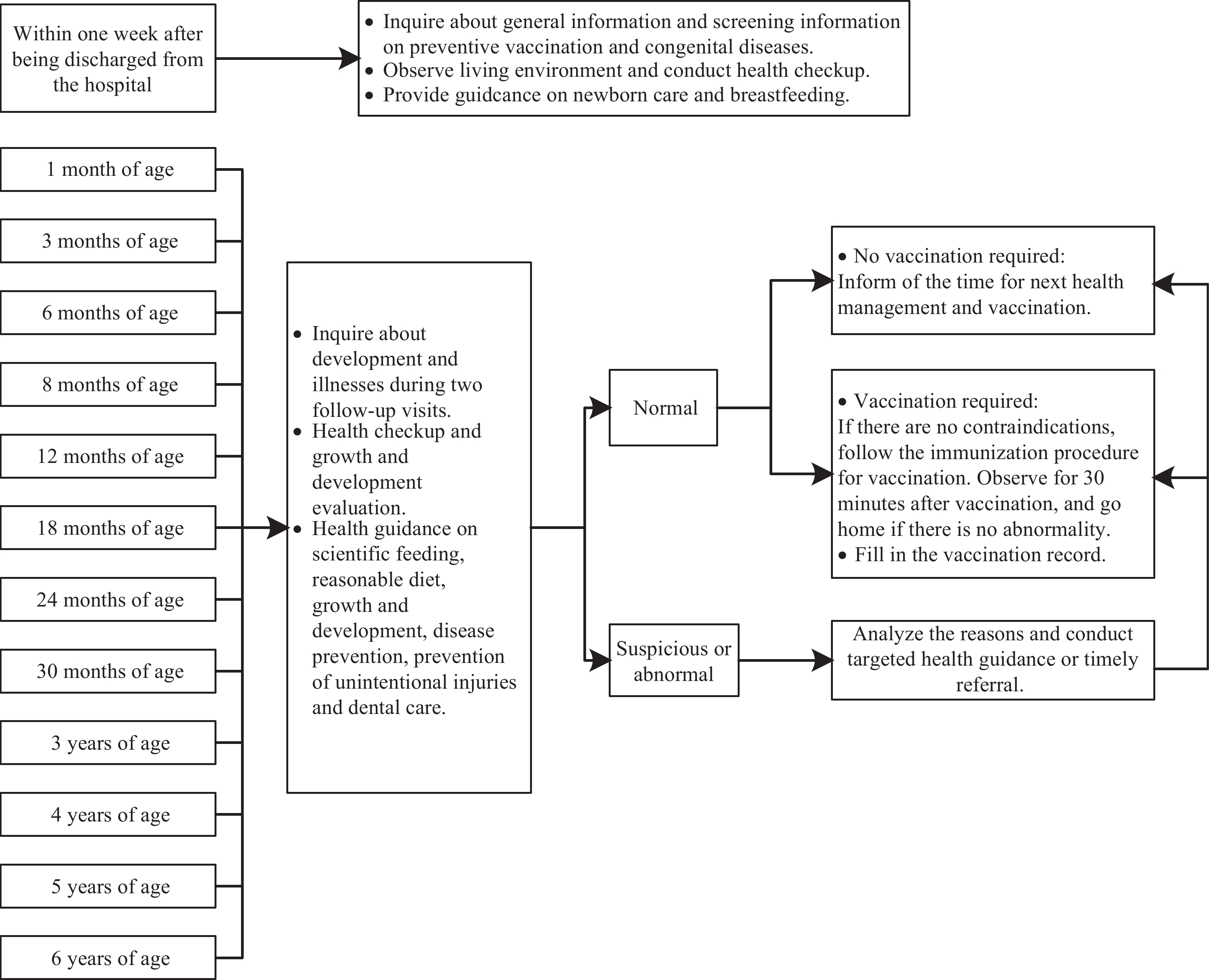-
When the People’s Republic of China (PRC) was founded in 1949, the country experienced a high incidence rate of acute and chronic infectious diseases in children, with frequent outbreaks of smallpox, cholera, kala-azar, schistosomiasis, and plague, among others. Thus, the top priority in child healthcare efforts was to prevent and reduce child deaths caused by infectious diseases (4). However, with socioeconomic development and changes in the disease spectrum of children, incidences of infectious diseases have been slashed significantly, while the impact of non-communicable diseases on children’s health has gradually become prominent. In addition to common infectious diseases such as pneumonia, diarrhea, and nutritional diseases, emotional and behavioral developmental problems in children have also received increasing attention. While continuing to implement strategies to ensure survival, China has recognized that measures also need to be taken to promote comprehensive early childhood development, and that child healthcare services should be provided in a systematic and continuous way instead of fragmented and sporadic. Since the founding of the PRC, health authorities have put in place a hierarchical maternal and child health (MCH) system to improve children’s health: providing continuous healthcare services for children from 0–6 years old (5).
-
The aim of establishing a child health management system was to improve the three-tier child healthcare service network at the county, township, and village levels; provide continuous health management services so that child development deviations can be detected at an early stage; and prevent and reduce diseases. These health targets have been included in the National Program of Action for Child Development (2021–2030), and require that every child receive equitable, accessible, comprehensive, and continuous healthcare services. By 2030, the goal is for the neonatal mortality rate, infant mortality rate, and under-5 mortality rate to be reduced to less than 3 per 1,000 live births, 5 per 1,000 live births, and 6 per 1,000 live births, respectively. Since the 1980s, China has established and implemented the National Maternal and Child Health Annual Report System and the National Maternal and Child Health Surveillance System. The former collects data on children’s health and healthcare services, such as neonatal visits; the health management rate of children; and their growth and development status. The latter collects data on child deaths and birth defects, such as neonatal mortality; infant mortality; and the mortality rate of children under five years old. Data from these information systems show that, in 2020, the national coverage of neonatal visits, the health management rate for children under 3 years old, and the health management rate for children under 7 years old all surpassed 92% (6). The national under-5 mortality rate decreased by 81.1%, from 39.7 per 1,000 live births in 2000 to 7.5 per 1,000 live births in 2020 (7). Meanwhile, the rural under-5 mortality rate dropped from 3.3 to 2.0 times the urban rate, suggesting a significantly reduced urban-rural gap. The prevalence of stunting among children under the age of 5 continued to decline, from 33.1% in 1990 to 4.8% in 2015. Furthermore, rural areas saw a larger margin of decline than urban areas. The prevalence of stunting among children under 5 in urban areas fell by 69.2% — from 11.4% to 3.5% — while, in rural areas, the figure dropped by 85.6% — from 40.3% to 5.8% (8). (Figure 1)
 Figure 1.
Figure 1.Trends of children’s health indicators in China from 1990 to 2020. (A) Trends in the health management rate of children under 5. (B) Trends in the under-5 mortality rate. (C) Trends in the prevalence of stunting among children under 5. (D) Trends in the incidence of underweight among children under 5.
Note: Data from 2010 to 2020 in (A)&(B) were obtained from the Maternal and Child Health Annual Report and China Health Statistical Yearbook. The data of 1992, 2002, 2013, and 2015 in (C)&(D) were obtained from the nutrition and health status monitoring of Chinese residents, and the rest were obtained from the food and nutrition monitoring system of China. -
The management of the child healthcare system features local physicians taking responsibility for child healthcare services within their areas and tiered management underpinned by the MCH service network. Community-based health facilities (urban community health service centers, rural township health centers, and some remote village clinics) are tasked with basic health management and disease screening through unified and standardized personal health management records. Once high-risk children with growth and development deviations or disorders are detected, they are referred to higher-level health facilities for further diagnosis and treatment. MCH hospitals, general hospitals, and specialty hospitals within the areas accept referrals from community-based health facilities and provide professional childcare services. The MCH hospitals at the county and district levels coordinate all MCH services in their areas, including general hospitals, specialty hospitals, and primary healthcare facilities (4). Furthermore, the National Health Commission (NHC) has issued working specifications for child healthcare, technical specifications on child healthcare, working specifications for healthcare services in kindergartens (along with other documents to regulate child healthcare services), and guidance for MCH hospitals at all levels to carry out continuous and standardized child healthcare services.
-
Before leaving the hospital, a newborn receives healthcare services from the obstetric facility. Afterward, the newborn will be included in the child healthcare management system in its area to receive follow-up services, including newborn disease screening, growth and development monitoring, feeding and nutritional guidance, emotional and behavioral development evaluation and guidance, vaccination, common disease prevention and treatment, and injury prevention and health promotion targeted at their parents. Children under the age of seven receive regular healthcare services, accompanied by their parents, at the child healthcare service department of urban and rural community-based health facilities (9). Such services include one neonatal home visit and one first-month neonatal health management visit, health checkups four times a year for infants under a year old, health checkups twice a year for children one to two years old, and annual doctor visits for children aged three to six. During each visit, relevant information will be recorded and included in the child’s health file. High-risk and sick children requiring referrals and consultations will be promptly referred to higher-level health facilities and receive follow-up visits. (Figure 2)
-
Child healthcare services have been part of the National Essential Public Health Service Program since 2009, giving all children access to free child healthcare services. Beyond that, the program provides free micronutrient sachets (Ying Yang Bao) for children aged 6–24 months in poor rural areas, and Traditional Chinese Medicine health management services for children aged 0–36 months. Since 2017, the NHC has been promoting the use of a unified MCH handbook across the country, as recommended by the World Health Organization, for home-based records for the care of pregnant women, mothers, newborns, and children. The goal is to improve care-seeking behaviors, maternal and child home care practices, infant and child feeding, and communication between health providers and caregivers (10). All handbook service items are provided by the government free of charge, serving as a commitment from the Chinese government to safeguard maternal and child health.
-
Since 2013, the former National Health and Family Planning Commission and the China Disabled Persons’ Federation have jointly issued the Working Specifications for the Screening of Disabilities in Children Aged 0 to 6 Years (Trial). Guided by this document, community-based health facilities use the Screening Checklist for the Warning Signs of Child Development Issues to conduct the initial screening for the five major types of disabilities (visual, hearing, physical, intellectual, and autism spectrum). They should then refer children with positive initial screening signs to re-screening facilities, while those with positive re-screening signs should then be referred to diagnostic facilities. Upon the diagnosis of a disability, the diagnostic facilities will provide information and link the disabled child with the resources for their rehabilitation and medical needs in relevant facilities. MCH hospitals at all levels have gradually established a working mechanism for the early screening, treatment, and rehabilitation of children with disabilities. The proportion of community health service centers and township hospitals carrying out the initial disability screening service for children 0–6 years old has increased year on year, reaching over 85% in 2018 (11). Through the implementation of this program, the prevention and treatment of common childhood diseases has been strengthened and children’s health has been advanced in a comprehensive manner.
-
China gives universal child healthcare coverage top priority and has established a hierarchical MCH management system to provide continuous child healthcare services. The equitable and universal coverage of child healthcare services has been achieved by capitalizing on China’s unique administrative management system; the community-based MCH service network at the county, township, and village levels; and the National Essential Public Health Service Program. After decades of unremitting efforts and practice, the health status of children has improved significantly. However, new issues such as obesity, myopia, and psychological problems have emerged. Moreover, in terms of comprehensive protection of children’s health, there are still challenges such as the unbalanced development between east and west regions and inadequate services in rural areas, among others. Thus, China currently cannot fully meet the growing health needs of children. Therefore, while enriching and expanding child health services, the country will have to add more policy and intervention components and take into consideration socioeconomic development and the needs of the people in order to promote comprehensive early childhood development.
-
No conflicts of interest.
HTML
Improving the Management Network of the Child Healthcare System
Providing Continuous Child Healthcare Services
Including Child Healthcare Services in the National Essential Public Health Service Program
Strengthening Early Screening and Treatment of Common Childhood Diseases
| Citation: |




 Download:
Download:





